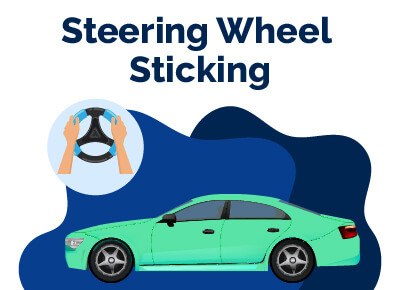Steering Wheel Sticking (6 Major Causes and Fixes)
July 25, 2023


Chris is Head of Content for FindTheBestCarPrice and is based out of Philadelphia, PA. As a seasoned automotive industry analyst and car enthusiast, he ensures the highest level of quality across all our content and curates our picks for the best deals each month.
Chris studied information systems and marketing at Drexel University and writes about a wide range of topics ranging from car buying tips to troubleshooting common mechanical issues.
When he’s not thinking about cars, he likes to stay in with his dog and make an “attempt” to finish a crossword puzzle (he’s not quite at the Saturday/Sunday level…yet). As a former cheesemonger, Chris still has a “sharp” passion for all things cheese, and his fridge is always loaded with it!
Chris also has a passion for things that go fast, and drones are no exception. He spends some of his time writing for Dronesourced.
When it comes to owning a car, the smooth operation of your steering wheel is non-negotiable. It's your direct line to navigating turns, dodging unexpected roadblocks, and safely changing lanes. However, encountering a sticking steering wheel can quickly turn a routine drive into a challenging ordeal, raising both concern and the need for immediate action.
At FindTheBestCarPrice, while our main focus is helping you find the best deals and providing buying advice, we also understand the importance of maintaining your car in top condition. A sticky steering situation isn't just an annoyance; it's a red flag for underlying issues that could compromise your control and safety on the road.
From the common culprits like low power steering fluid and worn-out belts to more complex issues with the steering rack or pump, we're here to guide you through identifying the major causes and navigating the fixes.
Let's get started...
Table of Contents
Causes of Steering Wheel Sticking Video
Top 6 Causes of Steering Wheel Sticking When Turning
The primary causes of a rigid steering wheel encompass poor upkeep, deferred servicing, or the attrition of specific components.
Neglecting these issues and allowing them to deteriorate may result in dire consequences, posing potential hazards. The following are the main reasons why your steering wheel sticks when turning:
1. Thickened Power Steering Fluid
If you experience a sticking steering wheel, one of the most probable culprits may be the thickening of the power steering fluid, an inevitable issue that transpires over time.
Like other fluids within a vehicle, the power steering fluid is not impervious to degradation, accumulating dirt, and debris over its lifespan.
Thus, adhering to the manufacturer's recommended intervals for regular fluid replacement is imperative.
Neglecting this crucial maintenance task can result in the thickening of the fluid, impeding its ability to lubricate the system properly.
Although a thickened power steering fluid may still permit some wheel turning, it requires excessive force and can prove dangerous under challenging situations requiring quick steering.
The sole resolution is to thoroughly flush the aged fluid from the system and replenish it with fresh, new power steering liquid.
2. Damaged Steering Rack
The steering rack is a pivotal component within the rack and pinion unit, which is critical in connecting the steering wheel to the mechanisms responsible for directing the wheels according to the intended navigation.
The steering rack facilitates seamless steering through a complex arrangement of shafts and U-joints. However, prolonged driving can inevitably lead to wear and tear on these intricate parts, including the steering rack.
Suppose you encounter difficulties turning the steering wheel immediately upon starting the vehicle but notice that the wheel gradually becomes smoother to maneuver as you continue driving.
In that case, the issue is likely attributable to a faulty steering rack. This phenomenon occurs due to the warming up of the rack as the engine operates, allowing the lubricant to settle in.
While it may be possible to continue driving in this condition, neglecting the deteriorated steering rack can exacerbate the problem and lead to further complications.
3. Low Power Steering Fluid
An ample quantity of specialized power steering fluid is indispensable for the power steering system to function optimally.
This fluid is the conduit through which power is transmitted from the steering wheel to the steering mechanism, enabling the wheels to turn.
Furthermore, it plays a crucial role in lubricating and safeguarding the various movable components within the system from overheating and corrosion.
The primary culprit behind a stiff or hard-to-turn steering wheel is often inadequate power steering fluid levels in the system.
This can occur when there is a leak in the pressurized hose area or when the connections in this region become loose.
The leakage from the crack reduces pressure in the system, compelling the power steering pump to work harder to compensate for the loss.
Consequently, the steering wheel is deprived of sufficient fluid supply, necessitating greater force to maneuver than usual.
While refilling the power steering fluid reservoir may temporarily resolve the issue and allow the vehicle to remain drivable for a while, it is imperative to address the underlying leak.
Failure to do so may eventually lead to a costly failure of the power steering pump, necessitating replacement.
Hence, it is crucial to promptly address any power steering fluid leaks to avoid further damage and expenses.
4. Faulty Serpentine Belt
Another prevalent factor contributing to a stiff or hard-to-turn steering wheel is a cracked or broken serpentine belt.
This essential belt performs numerous functions within the engine, including the operation of the power steering pump.
However, with constant use during vehicle operation, the serpentine belt undergoes wear and tear, leading to its eventual aging, loosening, cracking, and fraying.
As the serpentine belt becomes loose or damaged, it can manifest as stiffness in the steering wheel.
Neglecting timely repair or replacement of the belt can result in complete belt failure, rendering the steering wheel unresponsive and ineffective.
Furthermore, a loose or broken serpentine belt can also impact the functioning of other crucial components that depend on it, such as the water pump, alternator, and air conditioning compressor.
Moreover, a faulty belt can cause damage to the pulley system and potentially lead to overheating of the vehicle, posing additional risks and damages.
Hence, prompt attention to a compromised serpentine belt is imperative to prevent further complications and ensure the proper functioning of the steering system and associated components.
5. Poor Tire Pressure
Suboptimal air pressure in tires contributes to the challenge of a stiff or hard-to-turn steering wheel. Incorrect tire pressure, particularly underinflated tires, can serve as a triggering factor for this issue.
It is imperative to ensure that all tires on your vehicle are inflated following the manufacturer's recommended PSI.
Additionally, proper front-end alignment is crucial. Uneven wear on the front tires can cause the vehicle to pull to one side during driving or turning.
Uneven tire tread can result in misalignment of the wheels, which can contribute to the difficulty and rigidity experienced while making turns on the road.
Ensuring proper front-end alignment is maintained can help mitigate the strain on the steering system and promote smooth and effortless vehicle handling.
6. Power Steering Pump Failure
The power steering system comprises two principal components: the rack-and-pinion unit and the power steering pump.
The power steering pump is the intermediary that transfers the steering fluid to the rack and pinion unit.
When the steering wheel is turned, the control valve in the system allows the fluid to flow into the pinion, enabling smooth wheel rotation with minimal physical effort.
As the steering wheel is turned, the pinion engages with the steering rack, directing the four wheels in the desired direction.
Furthermore, a crucial function of the power steering pump is maintaining optimal pressure within the system, ensuring effortless steering without excessive force.
If the pump malfunctions for any reason, the "power" aspect of the steering system falters, resulting in a hard-to-turn steering wheel.
While a malfunctioning pump may not cause a complete wheel lock, it requires significantly more force, posing a potential hazard when maneuvering sharp turns in emergencies.
Typically designed to endure thousands of miles of operation, a power steering pump may occasionally fail prematurely.
Before the failure, a defective pump often emits a whining or groaning noise, particularly during sharp turns. As engine RPMs increase, this noise may become more pronounced and persistent, given that the pump is belt-driven.
It should be noted that loose or damaged connectors to the pump can also cause pump failure.
Therefore, inspecting and ascertaining if these connectors are the root cause of the issue before promptly opting for pump replacement is advisable.
Common Fixes to Steering Wheel Sticking
After identifying the root cause of the sticking steering wheel, you can proceed with rectifying the issue.
Here are some potential remedies for the problems mentioned earlier.
Replace Bad Serpentine Belt
A broken serpentine belt must be replaced if it is determined to be the culprit. If you possess mechanical aptitude, this task can be accomplished independently.
However, if you lack the requisite expertise, it is prudent to seek the assistance of a skilled mechanic.
Replacing A Faulty Steering Rack
Replacing a faulty steering rack requires a mechanic's expertise, as it is a complex task requiring specialized knowledge and equipment.
Top-Up Power Steering Fluid Frequently
In the case of low-power steering fluid, the solution is as straightforward as replenishing the fluid in the system.
If you possess the necessary expertise, you may undertake this task independently. However, if you are uncertain, it is advisable to consult a skilled mechanic.
Remove Bad or The Wrong Power Fluid and Use The Right One
If you have used the wrong type of power steering fluid, the resolution entails purging the system and refilling it with the correct fluid.
While this task can be accomplished independently, entrusting it to a qualified mechanic for optimal results is prudent.
Furthermore, when using a thickened power steering fluid, the remedy entails purging the system and refilling it with the correct fluid.
Again, this task can be undertaken independently, provided you possess the necessary know-how. However, seeking the guidance of a qualified mechanic is advisable for optimal results.
Replace Bad Steering Pump
When your steering wheel is sticking, you can replace your malfunctioning steering pump with a new aftermarket pump. This is a task a skilled mechanic can accomplish.
Best Car Deals by Category
Posted in Car Buying Tips, Car Troubleshooting |




